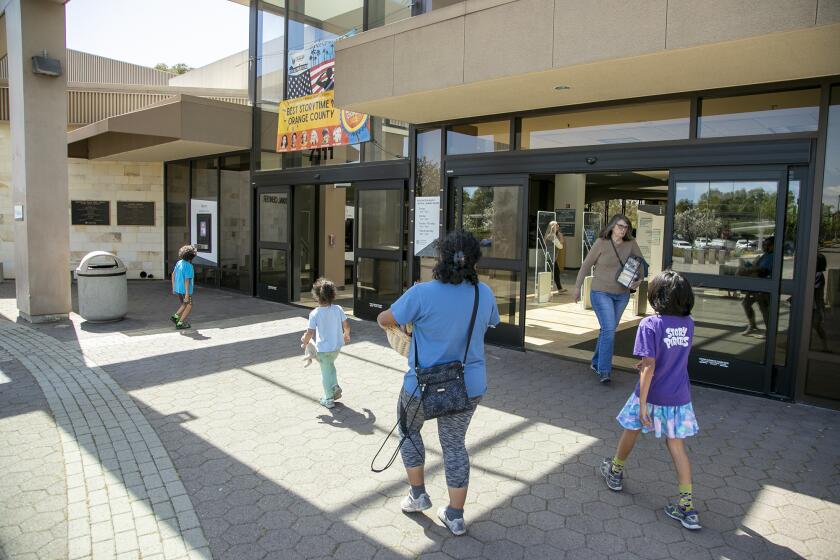Apodaca: Economists express optimism about Orange County recovery

- Share via
During the past year-and-a-half, the toll wrought by the COVID pandemic on many employers and workers has ranged from the annoying to the excruciating. Jobs were lost, businesses went under, and a lot of people only managed to scrape by with the help of government assistance and some creative maneuvering.
Now that the Orange County economy is fully reopened — or at least approaching that benchmark — what can we expect in the months ahead?
While trying to make ironclad predictions about the future business climate is a fool’s game, we do have hints about where we’re heading and, thankfully, we now have some reason for optimism.
Indeed, some experts who are well-versed in examining the economic tea leaves point to signs of healthy growth in the coming months.
We’ve already seen some positive indicators, including a significant decline in unemployment from pandemic highs and surging numbers of new business applications.
To be sure, the heightened expectations are tempered by growing concerns about the possibility of inflation and real estate bubbles, and by continuing worries that we’ll experience another wave of contagion severe enough to necessitate renewed restrictions.
Earlier this month Los Angeles County returned to an indoor mask-wearing mandate because of rising coronavirus infection levels. It’s unclear how it would impact the broader economy if other localities, including Orange County, follow suit.
Nonetheless, on the whole economists and business professionals are cheerier than they’ve been in awhile. What’s more, they are seeing some intriguing possibilities emerging that point to marked differences, and advancements, that could help lead us out of the crisis and toward a fundamentally altered economy.
Raymond Sfeir, director of the A. Gary Anderson Center for Economic Research at Chapman University in Orange, produces the school’s widely followed economic forecasts. He projects that economic growth in Orange County will continue ramping up for the remainder of the year, and will log in at a robust 7.6% in the third quarter.
In large measure that growth will be fueled by the comeback of sectors that were most hurt by the pandemic, including restaurants, and the leisure and hospitality industry.
“The coronavirus is not the same as a financial disaster or real estate crisis,” he observed. “It was a lack of demand because people were at home” that led us into a sudden and deep recession.
Now the economy is rebounding sharply as consumers are going out more and spending money again, while we’re also still benefitting from low interest rates and federal stimulus funds.
That’s why the recession and recovery have taken on the shape of a “V” on a graph, rather than the more typical “U-shaped” pattern, Sfeir said.
Because of the unusual nature of this recession and recovery, some developments that were already forming before the pandemic were greatly accelerated. These include technological advancements designed to satisfy the demands of consumers — think apps and telecommunications services that facilitate trade. Now those advancements are a built-in part of our world.
Another facet to this recovery is the acute labor shortage that many industries are experiencing. As a result wages will begin to rise, but as they do, Sfeir said, businesses will also increasingly turn to artificial intelligence and robotics to perform many tasks.
But here’s the kicker: “I do not believe the new technology is going to create more unemployment,” he said. “In fact it’s the opposite. I’m not really worried.”
Sfeir noted that we’ve heard dire predictions before. When computers started to become ubiquitous people expected that a surge in joblessness would follow. That didn’t happen, but the nature of work did shift to accommodate growing demand for workers to support a more technologically oriented economy.
Now Sfeir expects a similar occurrence as AI proliferates, with skilled jobs in sectors such as technology, education, information services and health care becoming increasingly plentiful.
John Bradley Jackson, director of the Center for Entrepreneurship at Cal State Fullerton, also believes that in many respects there will be no going back to the way business was conducted before the pandemic.
“There’s tremendous opportunity to enhance services through alternative distribution channels,” he said. “Let’s embrace that.”
When his senior-level and graduate students return to the classroom this fall — at least some of them will return to a physical classroom — he plans to challenge them to become problem-solvers in this new environment.
“Rather than just reverting back, what can we do different,” he said. And he expects that after living through hardships, students will be itching to fix what they believe are problems and deficiencies.
“I think a lot of new ideas have been percolating,” Jackson said. “I think a Phoenix will arise from the ashes.”
Perhaps he’s right, and we will see an abundance of shrewd, innovative ideas for new products and services coming out of pandemic, with the potential to propel us into a prosperous future.
Of course, entrepreneurs are by nature optimistic and are willing to tolerate a high degree of risk while trying to turn their visions into reality. Even so, after all that we’ve endured, we could use a little infectious confidence that better times are coming.
All the latest on Orange County from Orange County.
Get our free TimesOC newsletter.
You may occasionally receive promotional content from the Daily Pilot.




